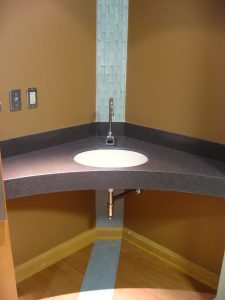 Did you know that it’s National Patient Safety Awareness Week? This annual education and awareness campaign for healthcare safety is led by the National Patient Safety Foundation.
Did you know that it’s National Patient Safety Awareness Week? This annual education and awareness campaign for healthcare safety is led by the National Patient Safety Foundation.
According to the NPSF website, this is a week to “recognize the advancements that have been made in the patient safety arena, while acknowledging the challenges that remain — and committing to work on them every day.”
So, let’s take a moment to recognize some of the design advancements that have been made for patient safety in the built environment.
- Single patient rooms help prevent the spread of infection
- Visibility of hand washing facilities also help prevent the spread of infection
- Improved acoustics reduce noise and help reduce staff errors
- Better light and private space for work also help reduce staff errors
- Room layouts with clear visual access to patients help prevent falls
- Careful attention to flooring materials and characteristics can also help prevent falls
- Proper light levels and reducing glare can help prevent falls, as well
- Selection of non toxic materials for interior furnishings, flooring, fabrics, building products, etc. can help prevent disease
Most of these design advancements sound like common sense now. But there was a time when all this stuff was new. Now the issue is how do we integrate designing for safety into the facility design process?
Joint Commission Resources, a not-for-profit affiliate of The Joint Commission offers “Safe Health Design” consulting services — bringing quality and safety experts to collaborate with the design team during early planning. Using performance improvement methodologies, they help create safe, high-quality environments that also meet Joint Commission requirements.
And last year, The Center for Health Design received a three-year grant from Agency for Healthcare Research & Quality to further define and produce practical resources for design practitioners to use as tools to integrate patient safety into the various phases of facility design.
So far, the only thing to come out of this project is a report that found identifying key facility design requirements for patient safety are essential during pre-design. But it’s a good start — with the end goal to develop a comprehensive toolkit that will most likely have more than just the 8 design strategies I listed above.
It is good to see that these resources are available. Perhaps someday, if we work to make it happen, the design of the physical environment will also on the National Patient Safety Awareness Week’s educational agenda.
P.S. Please do me a favor — if you liked this post and like this blog, please share it with others by sending them the link or posting it on your Twitter, LinkedIn, or Facebook. Also, don’t forget to subscribe, so you’ll get emails when new content is posted. Thanks!
If you like this post, please share.

What’s my story? I’m a healthcare and senior living design knowledge expert who writes and speaks frequently about trends and issues affecting these two industries. I’m also a strategic marketing consultant and content creator, working with companies and organizations who want to improve the quality of healthcare and senior living through the design of the physical environment. You can reach me at sara@saramarberry.com.

